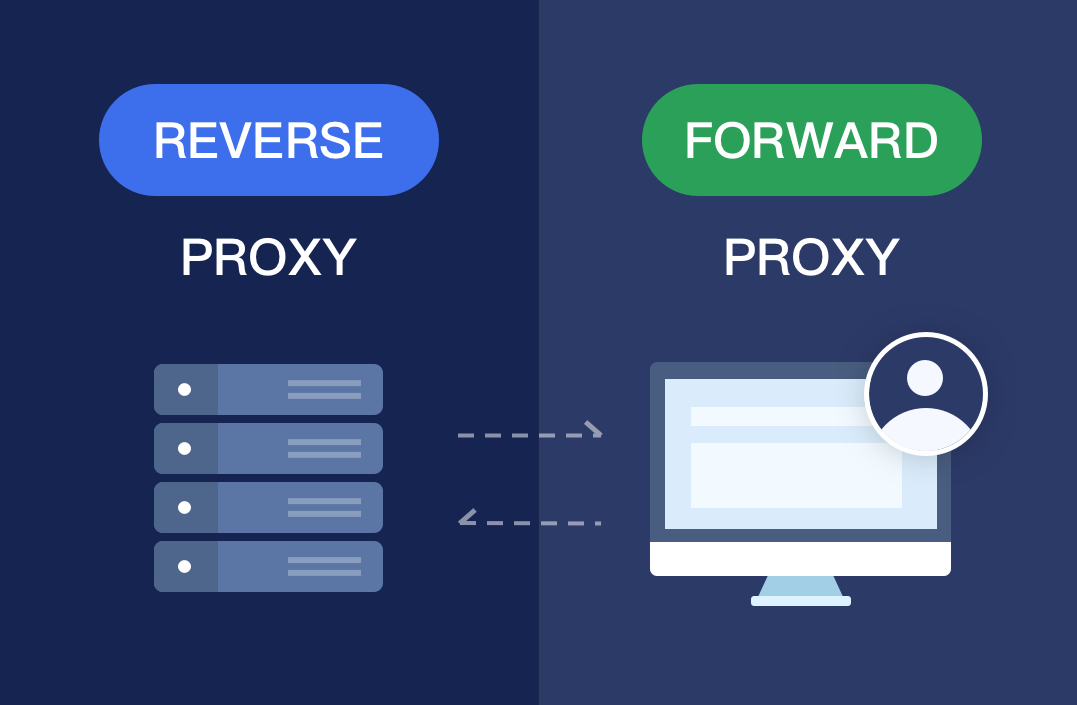In network architecture, a proxy server is a common middle-tier device that handles communication between clients and target servers. Among them, reverse proxy and forward proxy are two different proxy modes, and they have significant differences in working principles and application scenarios. This article will delve into the concepts, working principles of reverse proxy and forward proxy, and compare them in detail.
Reverse Proxy
1.Concept
A reverse proxy is a type of proxy server that sits in front of the target server, accepts client requests and forwards the requests to the back-end target server. The client only communicates with the reverse proxy and does not interact directly with the target server.
2.Working principle
Accept request: The reverse proxy receives the client's request.
Forward the request: The reverse proxy forwards the request to the target server on the backend.
Receive response: The target server sends the response to the reverse proxy.
Forward response: The reverse proxy sends the response to the client.
3.The main functions of reverse proxy include
Load sharing:Reverse proxy can share the load of the target server and improve the availability and stability of the website.
Caching data:A reverse proxy can cache response data from the target server to reduce network latency and increase data transfer speed.
Load balancing:The reverse proxy can distribute requests to multiple target servers based on load conditions to improve system throughput and performance.
SSL encryption:The reverse proxy can perform SSL encryption on the communication between the client and the target server to improve data security.
Forward Proxy
1.Concept
A forward proxy is another form of proxy server that is located between the client and the target server and initiates requests to the target server on behalf of the client. The target server only knows that the request came from the proxy server, not the existence of the client.
2. Working principle
Client request: The client sends a request to the forward proxy.
Proxy Requests: A forward proxy initiates requests to the target server on behalf of the client.
Receive response: The forward proxy receives the response from the target server.
Forward response: The forward proxy sends the response to the client.
3.The main functions of forward proxy include
Caching data: The proxy server can cache response data from the target server to reduce network latency and increase data transmission speed.
Filter data: The proxy server can filter the response of the target server, such as removing advertisements, malicious code, etc.
Authentication: The proxy server can verify the client's identity to ensure that only authorized users can access the target server.
Comparison of reverse proxy and forward proxy
1.Direction
Reverse proxy: The proxy server is located in front of the target server and receives client requests on behalf of the target server.
Forward proxy: The proxy server is located in front of the client and initiates requests to the target server on behalf of the client.
2.Object perception
Reverse proxy: The target server is not client-aware and only communicates with the reverse proxy.
Forward proxy: The target server is aware of the proxy request, but not the final client.
3.Scenario application
Reverse proxy: used to provide load balancing, SSL termination and other services.
Forward proxy: Used for access control, content filtering, anonymous access and other scenarios.
4.Security
Reverse proxy: Can hide the real IP of the backend server and improve security.
Forward proxy: Can hide the client’s real IP and provide anonymity.
5.Example
Reverse proxy: Nginx, Apache HTTP Server (as reverse proxy server).
Forward proxy: The proxy server is used to access foreign websites.
Summarize
Reverse proxy and forward proxy, as two different forms of proxy servers, play an important role in network architecture. Reverse proxy is mainly used for services such as load balancing and SSL termination, while forward proxy is used for access control, content filtering, anonymous access and other scenarios. This article introduces in detail the working principles and differences between forward proxy and reverse proxy. By understanding the characteristics and application scenarios of these two proxy services, we can better choose the appropriate proxy service to meet different needs. In actual applications, we can choose to use forward proxy or reverse proxy according to specific needs, or use a combination of both to achieve the best network effect.
Forward proxies are crucial for privacy and security when browsing the internet, accessing geo-restricted content, web scraping, and more. Reverse proxies are very important for websites with many visitors every day as they help avoid overload and are great for caching content, SSL encryption.
360Proxy provides 100% real residential proxy resources, covering 190+ countries and regions, and 80M+ residential IP resources. To meet the different needs of users, such as media account management, ESTY and SEO optimization, 360Proxy is a good assistant that can provide huge help!
 Username: Password
Username: Password
 Whitelist IP
Whitelist IP
 Proxy Manager
Proxy Manager
 Google Chrome Extension
Google Chrome Extension





























 Dashboard
Dashboard Sign Out
Sign Out





























 USA
USA France
France Brazil
Brazil Vietnam
Vietnam Spain
Spain









